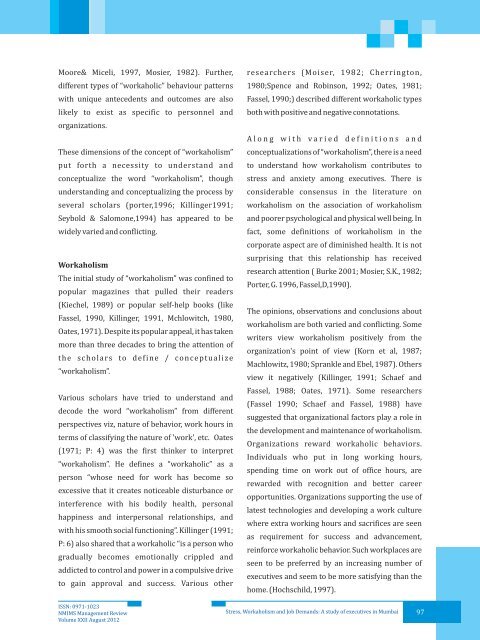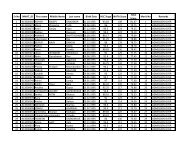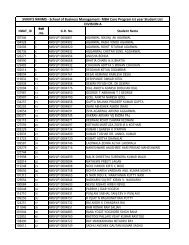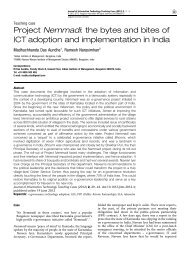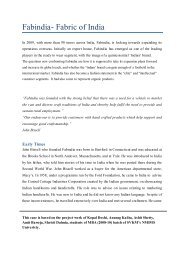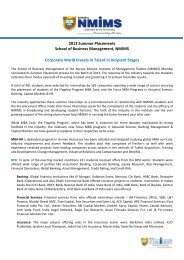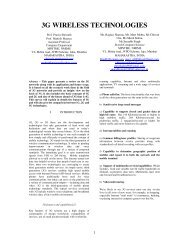NMIMS Management Review, Special Issue on Global Markets and ...
NMIMS Management Review, Special Issue on Global Markets and ...
NMIMS Management Review, Special Issue on Global Markets and ...
You also want an ePaper? Increase the reach of your titles
YUMPU automatically turns print PDFs into web optimized ePapers that Google loves.
Moore& Miceli, 1997, Mosier, 1982). Further,<br />
different types of “workaholic” behaviour patterns<br />
with unique antecedents <strong>and</strong> outcomes are also<br />
likely to exist as specific to pers<strong>on</strong>nel <strong>and</strong><br />
organizati<strong>on</strong>s.<br />
These dimensi<strong>on</strong>s of the c<strong>on</strong>cept of “workaholism”<br />
put forth a necessity to underst<strong>and</strong> <strong>and</strong><br />
c<strong>on</strong>ceptualize the word “workaholism”, though<br />
underst<strong>and</strong>ing <strong>and</strong> c<strong>on</strong>ceptualizing the process by<br />
several scholars (porter,1996; Killinger1991;<br />
Seybold & Salom<strong>on</strong>e,1994) has appeared to be<br />
widely varied <strong>and</strong> c<strong>on</strong>flicting.<br />
Workaholism<br />
The initial study of “workaholism” was c<strong>on</strong>fined to<br />
popular magazines that pulled their readers<br />
(Kiechel, 1989) or popular self-help books (like<br />
Fassel, 1990, Killinger, 1991, Mchlowitch, 1980,<br />
Oates, 1971). Despite its popular appeal, it has taken<br />
more than three decades to bring the attenti<strong>on</strong> of<br />
the scholars to define / c<strong>on</strong>ceptualize<br />
“workaholism”.<br />
Various scholars have tried to underst<strong>and</strong> <strong>and</strong><br />
decode the word “workaholism” from different<br />
perspectives viz, nature of behavior, work hours in<br />
terms of classifying the nature of 'work', etc. Oates<br />
(1971; P: 4) was the first thinker to interpret<br />
“workaholism”. He defines a “workaholic” as a<br />
pers<strong>on</strong> “whose need for work has become so<br />
excessive that it creates noticeable disturbance or<br />
interference with his bodily health, pers<strong>on</strong>al<br />
happiness <strong>and</strong> interpers<strong>on</strong>al relati<strong>on</strong>ships, <strong>and</strong><br />
with his smooth social functi<strong>on</strong>ing”. Killinger (1991;<br />
P: 6) also shared that a workaholic “is a pers<strong>on</strong> who<br />
gradually becomes emoti<strong>on</strong>ally crippled <strong>and</strong><br />
addicted to c<strong>on</strong>trol <strong>and</strong> power in a compulsive drive<br />
to gain approval <strong>and</strong> success. Various other<br />
researchers (Moiser, 1982; Cherringt<strong>on</strong>,<br />
1980;Spence <strong>and</strong> Robins<strong>on</strong>, 1992; Oates, 1981;<br />
Fassel, 1990;) described different workaholic types<br />
both with positive <strong>and</strong> negative c<strong>on</strong>notati<strong>on</strong>s.<br />
Al<strong>on</strong>g with varied definiti<strong>on</strong>s <strong>and</strong><br />
c<strong>on</strong>ceptualizati<strong>on</strong>s of “workaholism”, there is a need<br />
to underst<strong>and</strong> how workaholism c<strong>on</strong>tributes to<br />
stress <strong>and</strong> anxiety am<strong>on</strong>g executives. There is<br />
c<strong>on</strong>siderable c<strong>on</strong>sensus in the literature <strong>on</strong><br />
workaholism <strong>on</strong> the associati<strong>on</strong> of workaholism<br />
<strong>and</strong> poorer psychological <strong>and</strong> physical well being. In<br />
fact, some definiti<strong>on</strong>s of workaholism in the<br />
corporate aspect are of diminished health. It is not<br />
surprising that this relati<strong>on</strong>ship has received<br />
research attenti<strong>on</strong> ( Burke 2001; Mosier, S.K., 1982;<br />
Porter, G. 1996, Fassel,D,1990).<br />
The opini<strong>on</strong>s, observati<strong>on</strong>s <strong>and</strong> c<strong>on</strong>clusi<strong>on</strong>s about<br />
workaholism are both varied <strong>and</strong> c<strong>on</strong>flicting. Some<br />
writers view workaholism positively from the<br />
organizati<strong>on</strong>'s point of view (Korn et al, 1987;<br />
Machlowitz, 1980; Sprankle <strong>and</strong> Ebel, 1987). Others<br />
view it negatively (Killinger, 1991; Schaef <strong>and</strong><br />
Fassel, 1988; Oates, 1971). Some researchers<br />
(Fassel 1990; Schaef <strong>and</strong> Fassel, 1988) have<br />
suggested that organizati<strong>on</strong>al factors play a role in<br />
the development <strong>and</strong> maintenance of workaholism.<br />
Organizati<strong>on</strong>s reward workaholic behaviors.<br />
Individuals who put in l<strong>on</strong>g working hours,<br />
spending time <strong>on</strong> work out of office hours, are<br />
rewarded with recogniti<strong>on</strong> <strong>and</strong> better career<br />
opportunities. Organizati<strong>on</strong>s supporting the use of<br />
latest technologies <strong>and</strong> developing a work culture<br />
where extra working hours <strong>and</strong> sacrifices are seen<br />
as requirement for success <strong>and</strong> advancement,<br />
reinforce workaholic behavior. Such workplaces are<br />
seen to be preferred by an increasing number of<br />
executives <strong>and</strong> seem to be more satisfying than the<br />
home. (Hochschild, 1997).<br />
ISSN: 0971-1023<br />
<str<strong>on</strong>g>NMIMS</str<strong>on</strong>g> <str<strong>on</strong>g>Management</str<strong>on</strong>g> <str<strong>on</strong>g>Review</str<strong>on</strong>g><br />
Volume XXII August 2012<br />
Stress, Workaholism <strong>and</strong> Job Dem<strong>and</strong>s: A study of executives in Mumbai<br />
97


